Seasonic Platinum SS-1050XP3 & SS-1200XP3 Power Supply Review
by E. Fylladitakis on September 3, 2014 6:00 PM EST- Posted in
- Cases/Cooling/PSUs
- Seasonic
- 1200W
- 80Plus Platinum
- 1050W
Seasonic Platinum SS-1200XP3 Cold Test Results
This is a repeat (in case you skipped page three), but for the testing of PSUs, we use high precision electronic loads with a maximum power draw of 2700 Watts, a Rigol DS5042M 40 MHz oscilloscope, an Extech 380803 power analyzer, two high precision UNI-T UT-325 digital thermometers, an Extech HD600 SPL meter, a self-designed hotbox, and various other bits and parts. For a thorough explanation of our testing methodology and more details on our equipment, please refer to our How We Test PSUs - 2014 Pipeline post.
The energy conversion efficiency of the Seasonic Platinum SS-1200XP3 is, unexpectedly, noticeably better than that of its 1050W sibling. Once again, the maximum conversion efficiency manifests at 40% load (94.4%), with an average conversion efficiency within the nominal load range (20% to 100%) of 93.4%. From the chart, we can see that the Platinum SS-1200XP3 easily surpasses the 80 Plus Platinum efficiency requirements during our testing. At 10% load, the efficiency drop to 89.5% is very small, but at just 5% load it drops to 79.8%. Obviously using a 1200W PSU to drive a 60W load on a regular basis would be rather odd, so in most use cases the efficiency will be much higher.
Much like its less powerful sibling, the cooling profile of the Seasonic Platinum SS-1200XP3 is very aggressive, even with the fan set to hybrid mode. Even at room temperature, the fan starts at just 20% load. This time however, the Platinum SS-1200XP3 maintains very low noise levels up to 40% load, taking advantage of its very high efficiency. As the load increases above 50%, the speed of the fan increases radically, turning the silent 80 Plus Platinum certified unit into a hoover in no time at all. The operating temperature is very low, with the heatsinks hardly surpassing 55°C at maximum load, increasing the long-term reliability of the unit.


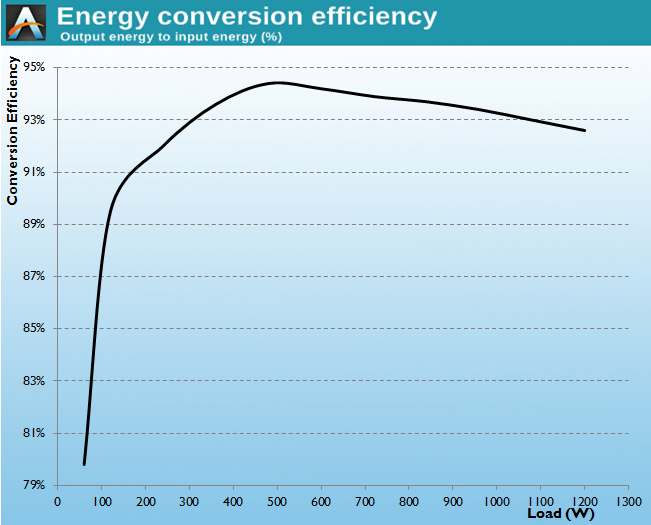
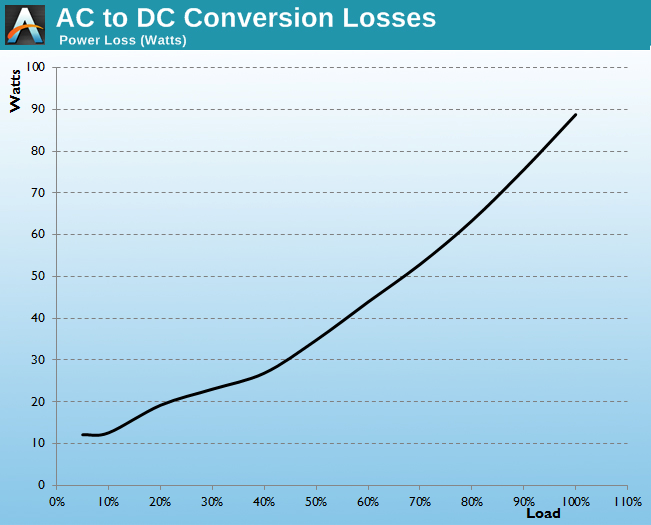
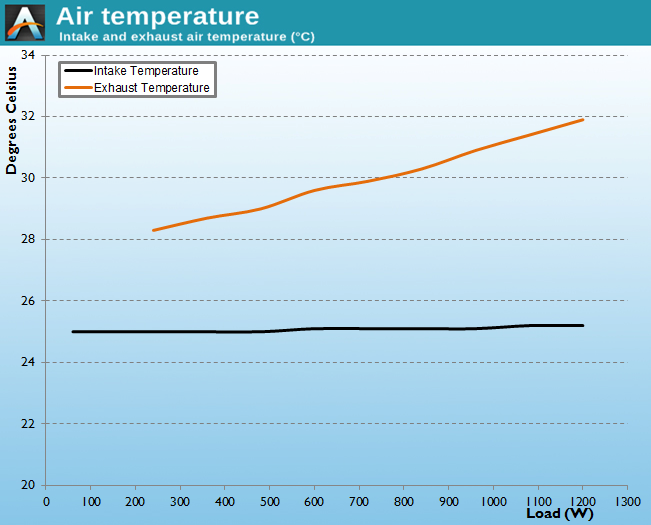
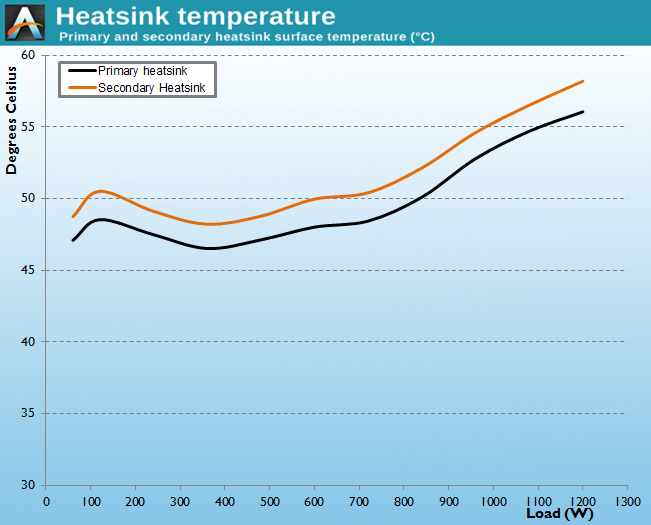
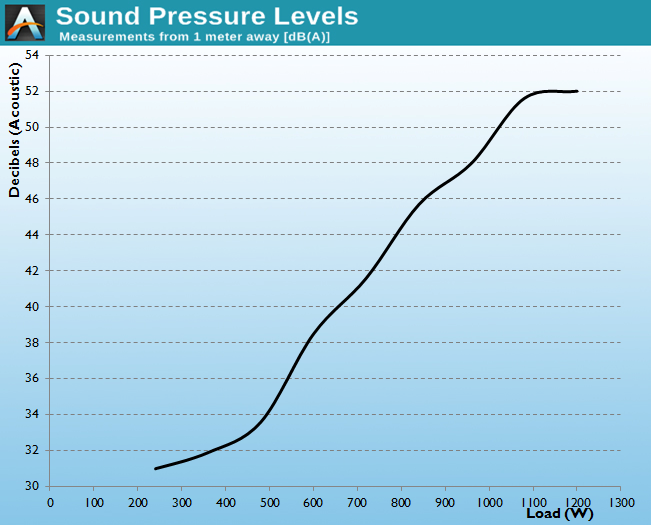








39 Comments
View All Comments
SodaAnt - Wednesday, September 3, 2014 - link
I still tend to be slightly annoyed at the low efficiencies with high power PSUs at around 5% load or 50-75W. I noticed the article even said "Obviously using a 1200W PSU to drive a 60W load on a regular basis would be rather odd, so in most use cases the efficiency will be much higher." However, I don't really think that's true. Maybe that would have been the case 5 years ago, but now even monster rigs will easily use less than 100W when they are just idle at the desktop, which is a surprising amount of time. Further, there's quite a large subset of users that get a 1200W power supply, yet use it in a build with a single GPU and CPU, merely because they think they might upgrade later.In short, efficiencies at the low end should be higher.
LtGoonRush - Wednesday, September 3, 2014 - link
76% efficiency at 5% load is EXTREMELY efficient, especially for a high-current power supply. There's a certain minimal overhead to power the electrical conversion hardware, and while it doesn't affect semi-passive models, the fan alone can account for 5% or more of efficiency losses at 50W draw. This overhead is also affected by the capacity of the power supply, as larger or parallel components increase overhead. The fact that a 1050W power supply is only wasting 12W of power at low load is quite respectable, and means that any improvements would have very minimal benefit.SodaAnt - Wednesday, September 3, 2014 - link
I think that wasting 12W of power at low load is actually quite a lot, mainly because the time scale is different. I'd say at least for my use case, 70% of the time is spent basically idling (internet browsing, writing a word doc, email, etc) or just not even using the computer at all. Especially for users who don't bother to turn off their computer, the 12W loss starts to add up pretty quick. I know its not easy to do, but I feel that because its not part of the spec for 80 plus, not very much effort is going into making improvements.RaistlinZ - Wednesday, September 3, 2014 - link
I think you expect too much. Anyone buying this is likely building a high-power overclocked rig, and wouldn't be spending much time at 5% power draw anyway. I also doubt the time, money, and effort into making PSU's 90%> efficient at 0-5% power draw is worth it from a manufacturing standpoint anyway.fokka - Thursday, September 4, 2014 - link
just because people are overclocking and gaming for a couple hours every day doesn't mean the close-to-idle times are negligable. people will still browse the web, write an email or watch a video or two.i'm not saying the inefficiencies at idle have to amount to a big loss compared to running a 1kw-pc at full load, but taken for itself it's still enough to power a complete low powered computer.
i don't know about the engineering/physics side of things, but i'd say idle efficiency is still something manufacturers should look to improve.
Kutark - Sunday, September 14, 2014 - link
The point is primarily that there is a minimum overhead that is needed to operate a power supply, and reducing that overhead is extremely difficult and in the end is not worth it. For example, if it takes say 12w of overhead, reducing that by 25% would basically put you at 9w. The return for the effort is simply not worth it (increased component costs, engineering/design costs, etc). Not many people would pay say a 10% price premium just to have the 5% load efficiency be 10% better so they can save basically save $6 a year in electricity costs.I've honestly never understood why people can't seem to pick their battles with these things. I always love when i would see people get into arguments here over a HDD that uses 8.2w instead of another one thats say 9.6w because its a 15% difference and thats massive! Well the reality is, its 1.4w. Now, in a corporate SAN environment where you might have say 500 of these drives in an array, yeah, 15% is a big deal. But to a home user who might have at most 2 of these drives in their computer, you're talking about $4/yr in electricity costs.
Pick your battles.
dealcorn - Wednesday, September 3, 2014 - link
If you use your over-clocking rig to browse the Internet you are wasting lots more than 12W. Get a petite, passively cooled Bay Trail desktop for browsing. Save the big rig for when you need the horsepower.rarson - Sunday, September 21, 2014 - link
Spend several hundred extra dollars to save a few bucks a year? That doesn't make any sense at all.surt - Wednesday, September 3, 2014 - link
Why does any power supply need to run a fan at 50w draw. Even if you're only 50% efficient at that load, you shouldn't need to actively cool 25w. If that's your overhead, just start the fan later.Samus - Thursday, September 4, 2014 - link
I want to chime in and agree with the OP here. Any PSU over 600W is going to be inherently inefficient at idle in many PC's.Below are my overclocked i5-4790 PC's individual power draw specifications taken with my Fluke multimeter, GW INSTEK GDS-122 oscilloscope using additive\deductive component elimination to calculate these measurements at idle within a reasonable margin of error using a PC Power & Cooling 750-QUAD 80-Plus PSU (which is really irrelevant since I am measuring current draw and using ohms law to convert into watts - the PSU has no bearing on the components individual power consumption.) However there is no reliable way to measure below 1 watt so the individual minimum component draw is such.
Core i5 4690K @ 4500MHz 1.210v draws 12.8w at idle (FIVR reported via CoreTemp)
2x8GB Crucial LPDDR3 @ 1600MHz 9-9-9 1.35v memory draws 3.2w at idle
Samsung 840 Pro 256GB SSD 1.0w at idle
Seagate 4TB 5900RPM 2.8w at idle
WD 2TB 5200RPM (2.5") 1.7w at idle
ASRock H87M-ITX measured via ATX connection 3.3+5.0+12.0 deduction 17.5w at idle
EVGA nVidia Geforce 780Ti 3GB clocked 1025/7400 1.189v 22.8w at idle
Total system draw before PSU efficiency loss is 62 watts. Since my PSU is only 75% efficient at 5-10% load, like most PSU's, my total system idle measured at the wall (with a somewhat accurate kill-a-watt) is 85 watts.
However, I need a 750-watt PSU as my load power consumption can surprisingly eclipse 600-watts at full CPU + GPU load and I want to remain below the 80% load barrier where the PSU lifespan is shortened, temperatures and noise escalate and efficiency can REALLY take a dive.
I think more attention needs to be taken with PSU efficiency at low idle state. There are various ways to do this, the most practical implementation being a dual stage power delivery circuit for different loads. Basically it would be a switching PSU inside a switching PSU, and it wouldn't be very expensive to produce because the first stage (lets say 0-100w) would be a very basic CLASS V, then there would be a voltage regulator and relay system that switches to the next stage with a supercap to isolate any voltage drop while switching.
I'm surprised nobody has done this yet. Should I patent it?